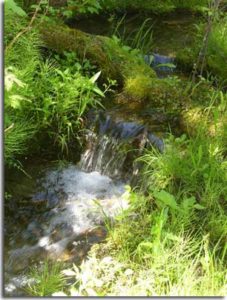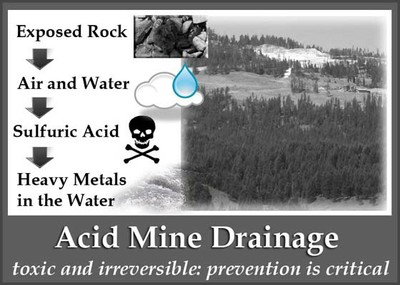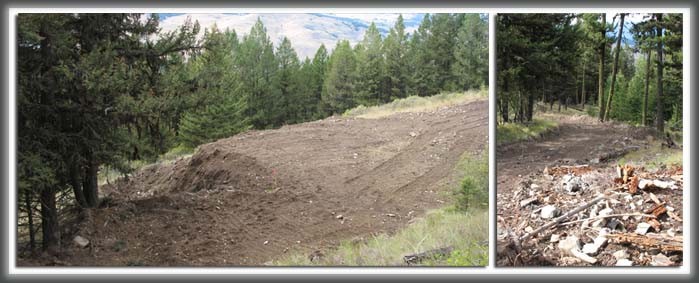How Gold Mining Can Affect Water Quality
There are several ways in which gold mining can affect water quality. Some of the following information is taken from the Safe Drinking Water Foundation online article, “Mining and Water Pollution.” Local photos are displayed, pertaining to Buckhorn Mountain and the associated facilities.
Introduction

Water is essential to life on our planet. A prerequisite of sustainable development must be to ensure uncontaminated streams, rivers, lakes and oceans.
Mining affects fresh water through heavy use of water in processing ore, and through water pollution from discharged mine effluent and seepage from tailings and waste rock impoundments. Increasingly, human activities such as mining threaten the water sources on which we all depend. Water has been called “mining’s most common casualty” (James Lyon, interview, Mineral Policy Center, Washington DC). There is growing awareness of the environmental legacy of mining activities that have been undertaken with little concern for the environment. The price we have paid for our everyday use of minerals has sometimes been very high. Mining by its nature consumes, diverts and can seriously pollute water resources.
Negative Impacts
While there have been improvements to mining practices in recent years, significant environmental risks remain. Negative impacts can vary from the sedimentation caused by poorly built roads during exploration through to the sediment, and disturbance of water during mine construction. Water pollution from mine waste rock and tailings may need to be managed for decades, if not centuries, after closure. These impacts depend on a variety of factors, such as the sensitivity of local terrain, the composition of minerals being mined, the type of technology employed, the skill, knowledge and environmental commitment of the company, and finally, our ability to monitor and enforce compliance with environmental regulations. One of the problems is that mining has become more mechanized and therefore able to handle more rock and ore material than ever before. Therefore, mine waste has multiplied enormously. As mine technologies are developed to make it more profitable to mine low grade ore, even more waste will be generated in the future.
Waste from the Mining Process
Ore is mineralized rock containing a valued metal such as gold…The ore is crushed into finely ground tailings for processing with various chemicals and separating processes to extract the final product.

Types of Water Pollution from Mining

- Acid Mine Drainage
- Many of the metals being mined in North America, including the gold mined from Buckhorn, tend to be found in rock that contains sulfide minerals. When ore and surrounding rock are excavated during mining, the sulfides become exposed to water and air, and may form sulfuric acid. This acid in turn leaches metals and other substances from the rocks that can harm ecosystems. The acid will leach from the rock as long as its source rock is exposed to air and water and until the sulphides are leached out – a process that can last hundreds, even thousands of years. Acid is carried off the minesite by rainwater or surface drainage and deposited into nearby streams, rivers, lakes and groundwater. Acid mine drainage is considered one of the most serious environmental threats posed by mining, and it can devastate aquatic resources for generations.
- Heavy Metal Contamination & Leaching
- Heavy metal pollution is caused when such metals as arsenic, cobalt, copper, cadmium, lead, silver and zinc contained in excavated rock or exposed in an underground mine come in contact with water. Metals are leached out and carried downstream as water washes over the rock surface. Although metals can become mobile in neutral pH conditions, leaching is particularly accelerated in the low pH conditions such as are created by Acid Mine Drainage.
- Processing Chemicals Pollution
- This kind of pollution occurs when chemical agents (such as cyanide or sulphuric acid used by mining companies to separate the target mineral from the ore) spill, leak, or leach from the mine site into nearby water bodies. These chemicals can be highly toxic to humans and wildlife.
- Erosion and Sedimentation
- Mineral development disturbs soil and rock in the course of constructing and maintaining roads, open pits, and waste impoundments. In the absence of adequate prevention and control strategies, erosion of the exposed earth may carry substantial amounts of sediment into streams, rivers and lakes. Excessive sediment can clog riverbeds and smother watershed vegetation, wildlife habitat and aquatic organisms.

Water Quantity
Mining can deplete surface and groundwater supplies. Groundwater withdrawals may damage or destroy streamside habitat many miles from the actual mine site. [end quote from the Mining and Water Pollution article]